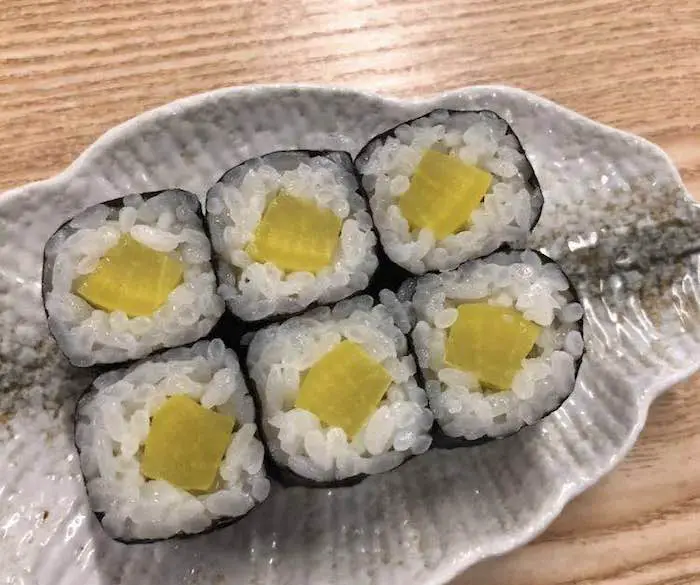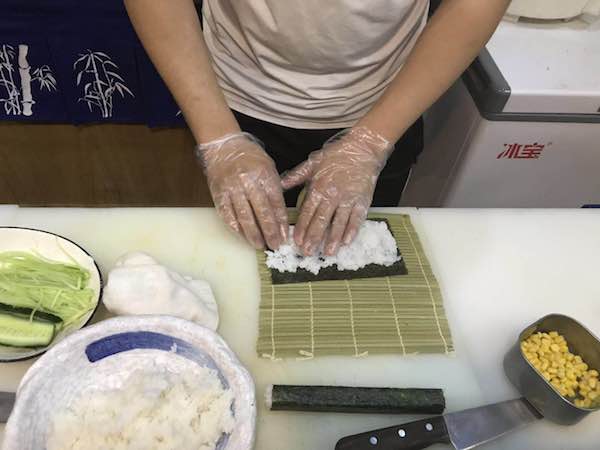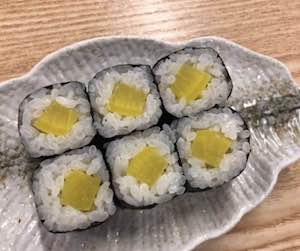We are reader supported. When you purchase through links on our site, we may earn an affiliate commission. Also, as an Amazon affiliate, we earn from qualifying purchases.

I know many people who will instantly think of raw fish and vinegared rice rolled in Nori sheet when they hear the word ‘sushi’. However, it’s worth noting that there are many options available for vegan sushi rolls and I don’t mean just cucumbers and avocados.
My vegetarian friends often complain about not having enough options for sushi. So, this post is specially dedicated to my vegan readers looking for exciting ingredients for maki roll. So, here’s presenting Oshinko (also known a ‘Takuan’), a Japanese yellow pickle that will find its way to your hearts.
While the pickles can be bought from a store, they are not always available. But, don’t lose heart because it’s extremely simple to make your own pickle at home. It takes about three days to get ready but let me assure you that it will be worth the wait.
What I like best about Oshinko is that you can prepare pickles at home and store them in the refrigerator. So, you have your ingredients ready to use anytime you are craving for delicious maki rolls. And, if you have vegan friends visiting you, don’t forget to delight them with your creation.
Contents
Oshinko Sushi Roll (Maki) Recipe
- 3 cups of cooked and seasoned sushi rice
- 4 sheets of toasted nori
- 2 Japanese or Persian cucumbers
- 8 strips of Oshinko or Japanese pickled vegetables
- 3-4 tablespoons plain mayonnaise
- 1/4 cup toasted sesame seeds
- 6 slices avocado
- Wasabi Sauce
- Pickled ginger
- Soy Sauce
Instructions
You need to start by cooking sushi rice and if you are a newbie there’s nothing to worry because I have explained the step-by-step instructions to cook and season sushi rice here.
Prepare fillings by cutting the cucumber into thin strips. Also, cut the avocado into equal halves and make thin slices. Gather all other items needed for making a sushi roll
Lay the bamboo mat on the plain working surface and cover it with a plastic sheet. Now place one Nori sheet on the bamboo mat, shiny side facing downwards.

Dampen your fingers, take a medium ball of sushi rice and spread it out on the nori sheet to make an even layer. Leave about ¾ inch on the top.
Arrange four cucumber strips and four Oshinko strips over the sushi rice. Add two slices of avocado and sprinkle some sesame seeds over it.
Lift the sushi mat from your side and start rolling working from bottom to the top. When you reach at the end, seal the edges with some water or rice grains.
Continue the above steps to make more sushi rolls using the remaining ingredients. Then take a sharp sushi knife to cut the roll into equal pieces. Serve in a plate with soy sauce and wasabi.
What Is Oshinko

If you are an ardent vegan sushi eater who likes to try every item on the menu, chances are that you have tasted Oshinko before. However, you may not be aware of the name. While usually labeled as the Oshinko roll or Oshinko maki, it may often be spelled as ‘oshinka’.
Typically made from daikon radish, Oshinko looks like a large sized white carrot that turns yellow when pickled. While radish is the most popular vegetable used for making Oshinko, some sushi restaurants may also use other green veggies like cucumbers, cabbage, lotus roots, and turnips.
Some restaurants may add food dye to color the pickled vegetables because the pickling process makes them look dull. However the sushi traditionalists will not approve of adding dye to pickles, so it’s your choice entirely when pickling at home.
The Oshinko sushi roll mainly consists of a Nori sheet, vinegared sushi rice, and oshinko rolled together and then cut into neat bite-sized pieces.
How Popular Is Oshinko Maki Roll In Japan
As this is a traditional cuisine, Oshinko is readily available in high-end restaurants as well as small eateries in Japan. They are also available in different flavors and varieties. However, in western countries, you may have to struggle to find a restaurant that serves Oshinko sushi.
As this maki delicacy has nothing to do with meat or seafood, it is extremely admired by the vegetarians around the world. Other than radish, several other types of pickled vegetables may be added to enhance the taste. In Japan, you can typically find cucumber sliced lengthwise and added with radish.
What Do You Know About The Pickling Tradition In Japan
Sushi and pickles have a deep connection and I am sure you are familiar with gari or pickled ginger like this used for cleansing the palate. A variety of vegetables are also pickled to add more flavor to the dishes and increase the shelf life.
The name of pickled vegetables usually changes with the different types of pickling solution used. While most of the pickled vegetables are known as Tsukemono, Oshinko is typically used to refer to those that use brine solution for pickling.
The pickling process, in general, takes several days to weeks when kept under sunlight or at a warm place. Fortunately, you don’t have to wait that long for oshinko as it takes much less time and tastes irresistibly good. This is possible because daikon radish is a high-fiber vegetable that readily absorbs the liquid.
What Is The Taste Of Oshinko?
Let’s first talk about the flavors because Oshinko is extremely popular for its irresistible taste. If you have had the chance to taste it, I am sure you will agree that it carries mild flavors of a radish. It’s more like a blend of carrots and radish put into one. The flavors are highly dependent on the method used and the choice of spices used for pickling.
If you take a bite of the Oshinko alone, your senses will send your mind a galaxy of signals. It may be difficult to label the flavor or taste with one word. Different people may actually have different interpretations but it ranges between the scale of salty, sweet, and savory.
A single bite of the Oshinko sushi roll offers such a wide range of flavors that it is hard to label it into a single word. It is a mixture of sweet, salty and savory flavors. When blended with sushi rice, it gets a more earthy taste and the seaweed adds more neutrality to it.
What Does An Oshinko Maki Roll Look Like
Next, let’s talk about the appearance that makes Oshinkoso sushi so unique. Homemade Oshinkoso may have a bright yellow color because of turmeric added to the brine solution. Talking about the overall appearance of an Oshinkoso maki roll, it has a distinct look with a green layer on the outside, white rice inside filled with delicious yellow pickled and light green slices of cucumber(optional).
Cucumber adds a dash of freshness to the roll and balances the sour taste of Oshinko. It also looks extremely tempting to the eye. However, the only issue some people may have is the smell that I will discuss next.
What Does Oshinko Smell Like
While the Oshinko looks and tastes really great, many people do not appreciate the smell of it. Well, I feel just like the acquired taste of uni, this is a kind of smell you need to get used to and like if you wish to enjoy an Oshinko sushi roll.
Is Oshinko Maki Roll Vegetarian?
Yes and I believe the idea of using this yellow pickle in sushi came from the quest of finding a vegan alternative for salmon. As raw vegetables cannot replace the flavor of salmon, the Japanese came up with something that is closer to salmon in flavor and liked by every Japanese – the yellow daikon radish pickle.
While the Oshinko maki recipe is purely vegan and can be safely eaten by all vegetarians, I would recommend that you confirm the contents when eating out at a restaurant. You can find a plethora of Oshinko varieties at the restaurants these days, however, they are mostly vegan.
Is Oshinko Maki Roll Gluten-free?
If you are looking for gluten-free options for lunch, you would want to ask this question, so here’s my answer for you. Unlike most other Japanese delicacies, the Oshinko pickle does not contain a lot of gluten but when it’s added to a roll, the gluten content increases in manifolds.
The highest content of gluten comes from sushi rice that may contain rice vinegar and sake. Hence, Oshinko is certainly not gluten-free. If you have intolerance towards the gluten products, you should avoid consuming Oshinko. Other delicacies using Oshinko such as Oshinko salad also contains a lot of gluten in it.
Related Article: Does Sushi Have Gluten?
How To Make Oshinko (Japanese Yellow Pickles) At Home
Still wondering where to find this Japanese pickle? You can find Oshinko at any Asian grocery store near you. If you live in an area where you don’t have access to an Asian grocery store, you may order it online from Amazon. For those who prefer to make things at home, here’s the quick and simple recipe.
What you will need
- 400 grams Japanese daikon radish
- Carrot (optional)
- Seedless Japanese or English cucumber (optional)
For seasonings
- 1.5 cup of water
- 1.5 cups of unseasoned rice vinegar
- 2 tbsp Kosher sea salt
- 1 tbsp sake (optional)
- 2 medium garlic cloves cut lengthwise
- 1 teaspoon turmeric powder
- 1/2 cup (100g) sugar
- 15 whole black peppercorns
- 2 bay leaves
Instructions
Wash the radishes and soak up excess water in a towel. Now, take a sharp Japanese knife and trim the stems and roots, about half inches from the radishes. Peel the skin gently using a peeler.
Put each radish on the working surface and cut them into 1/4″ size oval discs. It’s upon you whether you want big chunky pieces or make thin slices.
If you choose to use other vegetables like carrot and cucumber, wash and peel them too. Use a knife to make 1/4″ strips
Keep the vegetables aside and start preparing the pickle mixture. Take a medium-sized saucepan and put all the ingredients inside the pan. Crush the peppercorns slightly for a strong flavor. Keep boiling until sugar dissolves completely.
Now, turn off the heat and add the sliced daikon radish to the pickle mixture. Let it stand for 2 hours until the mixture cools and comes down to room temperature.
I recommend allowing the solution to sit for 3 hours to let the flavors blend beautifully. Then, strain the pickle mixture to get a clear brine solution without the whole spices.
Prepare an airtight glass jar like this and transfer all the pickle solution along with the vegetable slices inside it. I strongly recommend using a glass jar because a plastic jar will get yellow stains.
Pour the pickled vegetables along with the brine solution into the jar and cover the opening with a plastic wrap. Keep the jar in a cool and dry place and it should be ready to eat in the next three days.
After 3 days, remove the plastic wrap and secure the lid of the jar tightly. You may store the pickle in the refrigerator for about one month.
Related Questions
Is oshinko good for you?
Oshinko is basically pickled vegetables and the pickling process completely alters the chemical properties and creates benefits that were otherwise not present in the first place. It is a rich source of anti-oxidants and promotes weight loss. That does not mean that fresh vegetables are not good. They just have different health benefits.
What is oshinko called in English
Oshinko is a Japanese term that means ‘new fragrance’ and it is usually used to refer to pickled vegetables.
Why is oshinko yellow
Turmeric or other types of food coloring agents may be added to the brine solution while pickling. This results in oshinko turning yellow.
What is the difference between Oshinko and Takuan
They both refer to the same thing – Japanese pickled radish. Oshinko traditionally uses salt to pickle vegetables while Takuan was pickled using rice vinegar. Today, both Oshinko and Takuan may be made using rice vinegar and other flavoring agents.
Both have a strong flavor and may be used as a single filling in hosomaki, futomaki, and uramaki rolls. Besides sushi rolls, oshinko is also used in making salads and a variety of other dishes.
How to keep your Oshinko roll fresh
If you don’t plan to eat/ serve the Oshinko sushi immediately, wrap the pieces carefully in a plastic sheet to prevent the moisture from evaporating. Now refrigerate the Oshinko rolls to increase the freshness window.
What are the other vegetables used in making Oshinko rolls?
Besides daikon radish, you may also use carrots, Napa cabbage, turnips, burdock root and almost any other fibrous vegetable.
How long can Oshinko last?
Oshinko can last for several days even after opening the can if refrigerated properly. As a result, this is a readily available sushi ingredient you can use at any time of the day.

